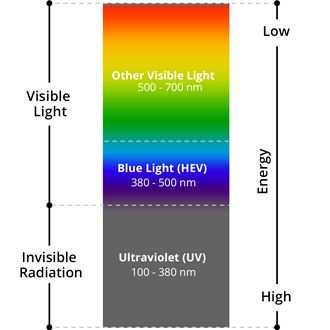Is Blue Light Actually Harmful to Your Eyes
Blue Light Facts: Is Blue Light Bad For Your Eyes?
What is blue light?
Visible light is more complex than you might think.
Stepping outdoors into sunlight; flipping on a wall switch in your house; turning on your computer, phone or other digital device — all of these things result in your eyes being exposed to a variety of visible (and sometimes invisible) light rays.
Most people know sunlight contains visible light rays and also invisible ultraviolet rays that can tan or burn your skin. But what many don't know is that sunlight contains a wide range of different-colored visible light rays that contain different amounts of energy.
Sunlight contains red, orange, yellow, green and blue light rays and many shades of each of these colors. The color of individual light rays depends on their energy and wavelength. Combined, the full spectrum of colored visible light rays creates what we call "white light" or sunlight.
Digital electronic devices emit blue light that can cause eye strain and may lead to eye problems over time.
Without getting into complicated physics, there's an inverse relationship between the wavelength of a light ray and the amount of energy it contains. Light rays that have short wavelengths have more energy and those with longer wavelengths contain less energy.
Rays on the blue end of the visible light spectrum have short wavelengths and high energy. Those on the red end of the spectrum have long wavelengths and less energy.
Invisible ray just beyond the red end of the visible light spectrum are called infrared radiation. The "warming lamps" you see in restaurants emit infrared radiation. (But these lamps also emit visible red light so people know the lamps are on! The same is true for other types of heat lamps.)
On the other end of the visible light spectrum, blue light rays with the shortest wavelengths (and highest energy) are sometimes called blue-violet or violet light. This is why the invisible rays just beyond the visible light spectrum are called ultraviolet (UV) radiation.
SEE RELATED: Does red light therapy protect the eyes?
The perils and benefits of UV
UV rays have higher energy than visible light rays (including blue light), which makes them capable of producing changes in the skin that create a suntan. The bulbs in tanning booths emit a controlled amount of UV radiation specifically for this reason.
But too much exposure to UV rays causes a painful sunburn — and even worse, can lead to skin cancer. These rays can also cause sunburned eyes — a condition called photokeratitis or snow blindness.
In moderation, however, UV rays have beneficial effects — such as helping the body manufacture adequate amounts of vitamin D.
Visible light and blue light
Generally, scientists say the visible light spectrum comprises electromagnetic radiation with wavelengths ranging from 380 nanometers (nm) on the blue end of the spectrum to about 700 nm on the red end. (By the way, a nanometer is one billionth of a meter — that's 0.000000001 meter!)
Blue light generally is defined as visible light ranging from 380 to 500 nm. Blue light sometimes is further broken down into blue-violet light (roughly 380 to 450 nm) and blue-turquoise light (roughly 450 to 500 nm).
So, about one-third of all visible light is considered high-energy visible (HEV) or "blue" light.
Key points about blue light
Like ultraviolet radiation, high-energy visible blue light has both benefits and risks. Here are important things you should know about blue light:
1. Blue light is everywhere.
Sunlight is the main source of blue light, and being outdoors during daylight is where we get most of our exposure to it. But there are many other sources of blue light — including LED lighting and flat-panel screens.
Most notably, the screens of computers, tablets, smartphones and other digital devices produce significant levels of blue light.
The amount of HEV blue light these devices emit is only a fraction of that in sunlight. But the amount of time people spend using these devices and the proximity of these screens to the user's face have many eye doctors and other health care professionals concerned. It's possible there may be long-term effects of blue light from computers and phones on the health of our eyes.
2. HEV blue light rays make the sky look blue.
High-energy blue light rays scatter more easily than other visible light rays when they strike air and water molecules in the atmosphere. This greater degree of scattering of blue light is what makes a cloudless sky look blue.
3. Our eyes are not very good at blocking blue light.
Structures in the front half of the eye (the cornea and lens) are very effective at blocking UV rays from reaching the light-sensitive retina at the back of the eyeball. In fact, less than 1% of UV radiation from the sun reaches the retina, even if you aren't wearing sunglasses.
(Keep in mind, though, that sunglasses that block 100% of UV are essential to protect these and other parts of the eye from damage that could lead to cataracts, snow blindness, pinguecula, pterygium, and even certain types of cancer.)
On the other hand, virtually all visible blue light passes through the cornea and lens and reaches the retina.
4. Blue light might increase the risk of macular degeneration.
The fact that blue light reaches the retina of the eye is important. Laboratory studies have shown that too much exposure to blue light can damage light-sensitive cells like those found in the human retina.
These changes seen in experimental conditions resemble those caused by macular degeneration, which can lead to permanent vision loss.
Although more research is needed to determine how much natural and artificial blue light from sunlight and digital devices is "too much blue light" for the retina, many eye care providers are concerned. The added blue light exposure in modern life from computer screens, smartphones and other digital devices might increase a person's risk of macular degeneration later in life. Until long-term population studies can be done, it's too soon to tell.
5. Blue light contributes to digital eye strain.
Because blue light scatters more easily than other visible light, it's not as easily focused. When we spend hours staring at computer screens and other digital devices, this poorly-focused visual "noise" from blue light reduces contrast and can contribute to digital eye strain.
Research has shown that lenses that block high-energy blue light in the 400-450 nm wavelength range increase contrast significantly. Therefore, computer glasses that filter blue-violet light in this range may reduce eye strain — especially if you use digital devices for extended periods of time.
6. Blue light protection is important after cataract surgery.
The lens of an adult eye blocks nearly 100% of the sun's UV rays. As part of the normal aging process, the eye's natural lens eventually blocks some short-wavelength blue light as well — the type of blue light with the highest potential to damage the retina and possibly cause macular degeneration and vision loss.
If you have cataracts and are about to have cataract surgery, ask your surgeon what type of intraocular lens (IOL) will be used in your procedure. Some IOLs may be better than others at restoring some level of blue light protection for your retina after surgery.
Also, when outdoors in daylight, always wear sunglasses that block blue light (as well as 100% of the sun's UV rays) after cataract surgery. And when using computers and other digital devices for extended periods, wear computer glasses that provide better blue light protection than standard reading glasses.
7. Not all blue light is bad.
So, is all blue light bad for you? Why not block all blue light, all the time?
Actually, some blue light exposure is essential for good health. So 100% protection from all blue light is not a good idea. Research also has shown that high-energy visible light boosts alertness, helps memory and cognitive function, and elevates mood.
In fact, the application of controlled levels of blue light is sometimes used to treat a condition called seasonal affective disorder (SAD). This is a type of depression that's related to changes in seasons, with symptoms usually beginning in the fall and continuing through winter.
The light sources for this therapy emit bright white light that contains a significant amount of HEV blue light rays.
Also, blue light is very important in regulating circadian rhythm — our natural wakefulness and sleep cycle. Exposure to blue light during daytime hours helps maintain a healthful circadian rhythm.
But too much blue light late at night (such as reading an e-book or browsing the web at bedtime) can disrupt circadian thythm, potentially causing sleepless nights, daytime fatigue, and even serious health problems.
Blue light filters and protective eyewear
If you are constantly using your phone for texting, emailing and web browsing, a convenient way to reduce your blue light exposure is to apply a blue light filter to the screen of your device.
Digital electronic devices emit blue light that can cause eye strain and may lead to eye problems over time.
These filters are available for smartphones, tablets, and computer screens and are available wherever electronics are sold.
Blue light filters reduce the amount of HEV blue light emitted from these devices from reaching your eyes without affecting the visibility of the display. Some are made with thin tempered glass that also protects your device's screen from scratches.
As mentioned above, blue light-blocking computer glasses can also be helpful to reduce blue light exposure from digital devices. These special-purpose glasses are available without an eyeglass prescription if you don't need corrective lenses or if you routinely wear contact lenses to correct your eyesight.
If you have even mild nearsightedness, farsightedness or astigmatism, prescription computer glasses can optimize your vision specifically for the distance from which you view your devices. This is especially important if you also have age-related presbyopia.
If you're over age 40 and routinely wear progressive lenses or bifocals, prescription computer glasses with single vision (one-power) lenses optimized for your computer viewing distance give you the additional benefit of a much larger field of view for seeing your entire screen clearly. Keep in mind, though, that this type of computer eyewear is exclusively for seeing objects within arm's length and should not be worn for driving or other distance vision needs.
Also, some anti-reflective coatings for eyeglasses and computer glasses (such as Essilor's Crizal Prevencia AR Coating) provide an added degree of blue light protection from sunlight and digital devices.
You may also want to consider photochromic lenses, which provide UV and blue light protection indoors and automatically darken in sunlight to increase comfort and reduce glare outdoors.
See your eye doctor or optician for more advice on the best computer glasses for viewing your screens and protecting your eyes from blue light.
Page published on Wednesday, February 27, 2019
Page updated on Wednesday, June 15, 2022
Medically reviewed on Thursday, May 6, 2021
Source: https://www.allaboutvision.com/cvs/blue-light.htm
0 Response to "Is Blue Light Actually Harmful to Your Eyes"
Post a Comment